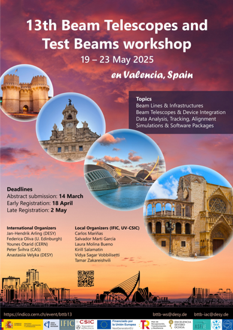Speaker
Description
The installations of detector upgrades for the High-Luminosity Large Hadron Collider (HL-LHC) will begin in late 2026. The luminosity is expected to increase by a factor of 7.5, reaching a total integrated luminosity of 4000 fb$^{-1}$. The number of collisions per Bunch Crossing (BX) will be between 140 and 200 with 1.5 vertex/mm. This poses important challenges for the tracking performance in the ATLAS experiment. The inner tracker will be replaced entirely to improve the tracking performance up to $|\eta| = 4$. However, its performance deteriorates in the forward regions of the detector. The High-Granularity Timing Detector (HGTD) is introduced to add timing information which, combined with the ITk spatial information, will allow it to recover its performance in the forward region where the ITk impact parameter resolution is degraded.
HGTD will comprise 8032 modules with a total of about 3.6 M channels. The modules consist of two hybrids each composed of a Low-Gain Avalanche Detector (LGAD) sensor bump-bonded to a Front-End readout ASIC, the ALTIROC.
This talk will discuss the HGTD test beam studies of test PCBs (single hybrid) and modules performed to obtain their time resolution and efficiency measurements at different operational points, i.e. different sensor bias voltages and ASIC thresholds. It will have a particular focus on the readout system for ALTIROC used in the test beam studies, called AlVin, and on the Corryvreckan module developed for the timing analysis and the evaluation and development of corrections for it, called Ullals.
